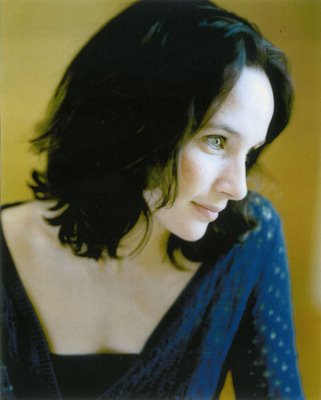 The effect of star power was on display Sunday night when pianist Hélène Grimaud gave a recital at Shriver Hall. The crowd was the largest and youngest in my experience of the venue, with all tickets sold out in advance and an overflow crowd, largely students, filling in the unused seats and some even allowed to sit on the stage. The last time that Grimaud came to Shriver Hall was eight years ago, and the number of people in or near Baltimore who craved hearing her again had apparently reached critical mass. The fact that her program, with the exception of the opening piece, came entirely from her two most recent recordings, all of it crowd-pleasing, created the perfect storm.
The effect of star power was on display Sunday night when pianist Hélène Grimaud gave a recital at Shriver Hall. The crowd was the largest and youngest in my experience of the venue, with all tickets sold out in advance and an overflow crowd, largely students, filling in the unused seats and some even allowed to sit on the stage. The last time that Grimaud came to Shriver Hall was eight years ago, and the number of people in or near Baltimore who craved hearing her again had apparently reached critical mass. The fact that her program, with the exception of the opening piece, came entirely from her two most recent recordings, all of it crowd-pleasing, created the perfect storm.The two pieces from her 2006 CD (reviewed earlier this week), the two Brahms rhapsodies (op. 79), sounded very close to the recording: Grimaud's conception of these pieces has apparently changed little in the year since laying them down last June. In the piano music of Brahms, the large stretches covered by the hands, the thick textures, and the need for considerable arm strength make matters difficult for many female pianists. I am convinced by Grimaud's readings of these rhapsodies, which are idiosyncratic, heavily pedaled, and emotionally forthright. Grimaud does arrive sometimes at her maximum dynamic too early, after which she is unable to rise above that plateau of sound.
Grimaud has said in interviews that she practices Bach first thing in the morning, as a sort of spiritual exercise, but she has not been drawn to his music much in performance or recordings. The Busoni arrangement of Bach's D minor chaconne (from the second partita for unaccompanied violin) that opened the program seemed the least familiar to Grimaud, not quite always fitting under her fingers. The tempo varied, in some cases wildly, from variation to variation, but the fullness of sound matched what Busoni said he was attempting to capture in this arrangement, a piece for solo violin fleshed out for the majesty of the organ (something Bach did himself for other movements from his solo string pieces).
 The best performances on the first half were the two near-impossible Chopin bon-bons recorded on her 2005 CD (reviewed last March). The Berceuse in D-Flat Major, op. 57, sounded even more delicate than on the recording, a fine mixture of rock-solid technique and gentle sound. Babies could have been lulled to sleep, but none were in the hall, thank God. The Barcarolle in F-Sharp Major, op. 60, is a twilight piece, completed in 1845-46, just a couple years before Chopin's death. Its evocation of Venice and the barcarola songs of the gondoliers is bittersweet. The ability to resolve the work's technical demands with its air of simplicity has eluded many players, but it seems to play right to Grimaud's strengths. Her affinity for Chopin, she told James Oestreich in a recent interview for the New York Times, comes partly from being left-handed, and Chopin calls equally on both hands.
The best performances on the first half were the two near-impossible Chopin bon-bons recorded on her 2005 CD (reviewed last March). The Berceuse in D-Flat Major, op. 57, sounded even more delicate than on the recording, a fine mixture of rock-solid technique and gentle sound. Babies could have been lulled to sleep, but none were in the hall, thank God. The Barcarolle in F-Sharp Major, op. 60, is a twilight piece, completed in 1845-46, just a couple years before Chopin's death. Its evocation of Venice and the barcarola songs of the gondoliers is bittersweet. The ability to resolve the work's technical demands with its air of simplicity has eluded many players, but it seems to play right to Grimaud's strengths. Her affinity for Chopin, she told James Oestreich in a recent interview for the New York Times, comes partly from being left-handed, and Chopin calls equally on both hands.Tim Smith, Powerful recital (Baltimore Sun, November 7) |
Hélène Grimaud plays the same program in a recital at Carnegie Hall tomorrow evening. We will add some links to the New York reviews later this week.
UPDATE:
Grimaud apparently played the program once between Baltimore and Carnegie Hall, at a concert in Troy, N.Y. Monday night (review in the Albany Times Union). She reportedly took a wrong turn on the road somewhere in New Jersey and was an hour late in starting the recital.
Carnegie Hall reviews:
Anthony Tommasini, Iron Fists Within Those Velvet French Gloves (New York Times, November 10)
Jay Nordlinger, Grimaud's Romantic Storm (New York Sun, November 10)
Did she have any wolves with her?
ReplyDeleteI was just offered a ticket for tomorrow night's concert! Looking forward to it. You know I'm not a critic, but I'll give you my report... =]
ReplyDeleteMark, I am afraid that one of these days I will read a newspaper article about how Hélène Grimaud has been killed by a wolf or had her hand permanently injured by a wolf. However, Jens made me promise to write this review without mentioning the damn wolves.
ReplyDeleteACB, I am glad you are going to hear her! Do please let us know what you liked and didn't like.
The first thing I thought was, YOUR HANDS! They bite, yo.
ReplyDelete